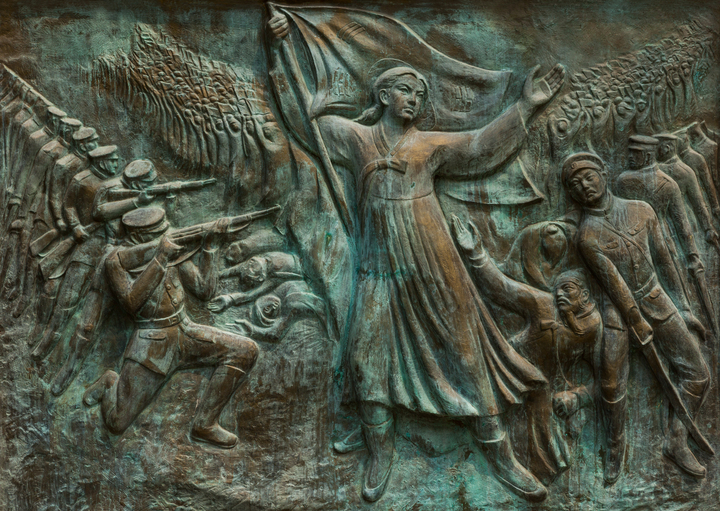It's Gwangbokjeol, Korea's liberation day, on 15 August. Let's learn more about its meaning. In addition to this, historic places that you can visit.
 The Meaning and History of Liberation Day
The Meaning and History of Liberation Day
Liberation Day, Gwangbokjeol in Korean, marks the day when Korea regained independence from Japanese colonial rule. The literal definition of ‘Gwangbok’ means to ‘regain the light.' It was a dark time when the sovereignty of the country had been taken away and the nation was ruled by Japan for 35 years. Under such circumstances, regaining sovereignty of the country through the courageous actions of independence fighters and many unknown independence activists has been perceived as the ‘light.’ Before the defeat of Japan at the end of World War II, many Koreans were harshly exploited as forced labor at home and abroad. After its defeat, Japan was forced to give up control of the peninsula, and as a result, liberation came to Korea.
 |
| Mongyang Yeo Woon Hyung Memorial Hall in Yangpyeong ⓒGyeonggi Province |
Historic Spot No.1 | Mongyang Yeo Woon Hyung Memorial Hall | Yangpyeong
On August 15, 1945, the Japanese handed over security authority of Joseon¹ to Mongyang after surrendering to the Allied Forces. At that time, Mongyang was considered to be the right person to provide leadership to the people. Mongyang formed the National Foundation Preparation Committee and opened 145 branches nationwide in just 15 days. With this, the Korean people showed their will and ability to establish their own nation. |
| Mongyang Yeo Woon Hyung Memorial Hall in Yangpyeong ⓒGyeonggi Province |
Mongyang Yeo Woon Hyung's Birthplace and Memorial Hall was established to properly promote his life, which has devoted to the independence movement. By the age of 20, he established a school and freed the family slaves. His efforts in the independence movement in Jilin Province, China, inspired the Tokyo Declaration of Independence, as well as the March 1 Declaration of Independence. In addition to the permanent exhibition where visitors can see depictions of Mongyang's life, visitors can also take pictures with images of Mongyang. Chroma-key techniques allow users to take photos as if they are really with Yeo Woon-hyung. After Korea's liberation from Japanese colonial rule, Mongyang spent the rest of his life striving for the unification of the two Koreas. Later, during the rule of military regimes, he was treated as a communist because of his interaction with Lenin, Mao Zedong and Ho Chi Minh. The Mongyang Yeowoon-hyung Memorial Hall, however, is a place that shows the life and noble spirit of a righteous independence activist.
Historic Spot No.2 | Birthplace of Shin Ik-hee | Gwangju
Seohari, Chonnam-eup, is a wide field where Shin Ik-hee, an independence activist and the first chairman of the Constitutional Assembly, was born. The road from Gwangju IC to Seohari on the Jungbu Expressway is named ‘Haegong-ro’ after Shin Ik-hee’s pen name. Shin walked this road every day when he attended Namhansan Elementary School, about 11 kilometers away, from the age of 12. |
| Birthplace of Shin Ik-hee in Gwangju ⓒGyeonggi Province |
When visiting Shin’s birthplace, there is a small parking lot right in front, but it is recommended that visitors walk from the bus stop in front of the Seohari Senior Center. Here, a monument featuring a statue of Shin Ik-hee and a stone tablet inscribed with his memorable quotes exist side by side. Once visitors enter the village, they can see the progress of democracy in Korea along with Shin’s traces. In particular, photos taken with State Council members, including those of Ahn Chang-ho, Dosan, during the National Assembly's activities in 1919 on the provisional charter of the Republic of Korea, are impressive. After traversing the narrow village road and passing the wall with his quotes, one can find Shin’s birthplace.
Historic Spot No.3 | Choi Yongshin Memorial Hall | Ansan
Choi Yong-shin, recipient of the Republic of Korea Order of Foundation, was an independence activist who devoted her life to the rural enlightenment movement. Not a well-known figure, Choi believed that the revival of Joseon was linked to rural areas, and that the development of the Korean people was to be found in its farmers. She taught reading and writing as well as sewing at a chapel, teaching Korean to young children who regarded Japanese as their mother tongue. |
| Choi Yongshin Memorial Hall in Ansan ⓒGyeonggi Province |
The Choi Yongshin Memorial Hall was built on the site of the Samgol Training Center where she taught children. It is a now public museum that was established by Ansan City to honor Choi Yongshin and a memorial facility designated by the Ministry of Patriots and Veterans Affairs. The facility includes a single-story tile-roofed house that is a restoration of the Samgol Training Center. The exhibition hall displays the Order of Merit for the National Foundation and the first edition of Sangnoksu, which were esteemed by Choi Yongshin. There will be a permanent exhibition, Dear Missed Teacher, where students can watch video essays and the movie Evergreen Tree.
¹a Korean dynastic kingdom that was founded in July 1392 and lasted for approximately five centuries






%209.jpg)
%203.jpg)
%205.jpg)
.jpg)
%201.png)

COMMENTS